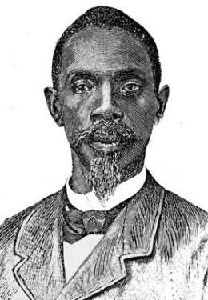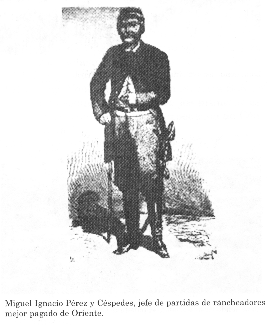|
Guillermón Moncada: Vencedor
del Rancheador Miguel Pérez Céspedes de Guantánamo, 5/05
Links
|
 Guillermón Moncada and the Defeat of ‘Rancheador’ - Slavehunter Guillermón Moncada and the Defeat of ‘Rancheador’ - Slavehunter
- Miguel Pérez Céspedes Of Guantánamo
by Eugène
Godfried, 5/05
INTRODUCTION
Not surprisingly, the official discourse in the Province of Guantánamo considers the arrival of José Martí on April 11, 1895 at Playa Cajobabo to be the most important historical event of that territory. This statement, indirectly discards the miraculous arrival on April 1st of 1895 at Duaba, Guantánamo, of Antonio and José Maceo and others, despite the mistake made by Martí in appointing Flor Crombet to be the head of that expedition which left from Puerto Limón, Costa Rica. Moreover, the oppressed, exploited, and humble masses of Guantánamo know several moments of great importance in their struggle for the liberation from Spain. Let us just take into account the brave struggles led by Guillermón Moncada, who put an end to the actions of the hated racist and ‘rancheador’ i.e. professional ‘slavehunter,’ Miguel Pérez Céspedes.
UNESCO calls on the peoples of the world to denounce slavery and racism. In order to achieve this goal one should see and defend history from the eyes of those who for more than five centuries were victims of the eurocentrist and eurosupremacist colonial system. Guantánamo has a significant presence of people of color, descendants of Africans, Indigenous, Asians and humble Europeans who traced landmarks in their liberation struggles.
Eugène Godfried
Caribbean specialist/journalist
Community organizer/author
Radio Habana Cuba
Radio CMKS de Guantánamo
AWARENESS OF UNITY
Guillermo Moncada was firmly aware of the fact that descendants of Africans and descendants of Europeans, simplistically categorized, ‘blacks’ and ‘whites’, shared one common interest: the Fatherland. Guillermón Moncada embraced this political principle entirely. The sentiment which led those fighters originating from among the humble and exploited layers of society to fight for independence was inseparable from the drive to fight at the same time for the abolition of slavery. There was a double preoccupation, which explains the reason why the genuine rebels adopted the slogan “PATRIA Y LIBERTAD” meaning “FATHERLAND AND LIBERTY”. Fatherland for all and liberty for those deprived from it.
HIS YOUTH
He was born June 25 of 1840 in Santiago de Cuba in the neighbourhood known as Los Hoyos, amidst a humble family of African descent. His mother was Dominga Trinidad Moncada and his father Narciso Veranes.
Guillermo Moncada spent his youth between the years 1841 y 1861, an era of rebellions of enslaved people at the canefields during the first half of the 19th Century. Those happened especially in the years 1812, 1840, 1841 y 1843. They were erroneously called ‘racist uprisings’ by the dominant colonial elite. One can remember that during what became known as the ‘La Escalera Conspiracy’ of 1844, both descendants of Africans and Europeans participated in that process. Moncada was born three years before the betrayal and death of Plácido, who was the main victim of the massacre which took place during the ‘Escalera’ incident.
The young Guillermo was brought up in the neighborhood of Los Hoyos, where the majority of people of African descent of Santiago de Cuba traditionally lived. Being those who were treated worst, they converted this neighborhood into a focus of constant rebellion. This neighborhood delivered most of the militants to the revolutionary struggles.
As an adolescent Moncada had to struggle for his daily bread. He worked as a carpenter, sawing wood in the countryside. With his elegance, he conquered the respect and admiration of his colleagues at work for whom he was a natural leader. He loved his parents and saved money for them. He could not finish the house he was building for his mother because he joined the Big War.
Those who knew him say that from his youth Moncada was very brave and generous, serious with his commitments, firm in his decisions, loyal to the utmost, always calm and speaking gently and with a low voice as a responsible man who thinks first about what he has to say. They also say that he gave the impression of being a man of extraordinary strong will. His physical aspect was that of very vigorous man, of gigantic stature, broad thorax, and walking straight up, deliberate. From his first years of life his friends called him because of his strength ‘Guillermón’, meaning Big Guillermo.
JOINING THE TEN YEARS WAR
Moncada was twenty-seven years old when Carlos Manuel de Céspedes initiated the War of 68. Céspedes understood that the black skinned man was very necessary in the war.
Approximately in the month of November, Moncada entered the mambisas ranks. Why? Why does a poor black skinned carpenter join a Revolution initiated by rich white skinned people? Because Céspedes’ act promised a better future with social changes to the descendants of Africans.
 |
|
Miguel Pérez Céspedes |
AN ANTIRACIST ATTACK ON GUANTÁNAMO –
Máximo Gómez, who had already been promoted to commander, sent Moncada to harass the colonial units of Miguel Pérez Céspedes, the well known and most feared ‘rancheador’ in the eastern part of the island. May 5th 1871, in Guantánamo, in a place belonging to Yateras called by some Palenque and by others Peladero, Guillermón Moncada succeeded in putting an end to the actions of the infamous head of the
barbarous Spanish squads during a five hour body to body confrontation or draw. To leave out any doubt whether the order was accomplished, he sent the badges and the sword of the defeated one as a symbol of victory to Máximo Gómez. Moncada was gloriously promoted to Lieutenant Colonel thanks to this significant deed.
GUILLERMON PERSISTS IN STRUGGLE
He made brilliant interventions in the famous actions of the Loma de la Galleta (July 12th 1871), La Loma de La Estacada (July 12th), the coffee estate La Indiana in Monterru (August 4th), coffee estate Dos Amigos (Ausgust 23rd), Monte Líbano (September 20th ). Coffee estate Oasis (November 20th) where the Cubans made General Carlos Palanca Guttiérez flee. Guillermón was too seriously injured and could not participate in the battles of Las Guásimas, Nuevitas y Cascorro.
Together with his comrades from the eastern part of Cuba, he returned to Oriente mid 1874. Under the command of Antonio Maceo, he fought, according to estimates made by Regino E. Boti, in over fifty actions, among which the battle of Guayabal, the take over of the convoy at La Florida, and the battles of La Llanada, of Juan Mulato, of Plurial in Guantánamo (February 3rd of 1877), of los Caños in Guantánamo (February 13th of 1877), of Jaibo near Caimanera, and of Arroyo Naranjo or Monte de San Ulpiano in Mayarí, where Maceo put him in command, because of the confidence he had in him, in order to defend the difficult obstacle.
After the peace with neither independence nor abolition of slavery as signed at Zanjón, Guillermón joined the other officers and Antonio Maceo, to support the bold PROTEST OF BARAGUÁ. ‘La Guerra Chiquita’ or ‘The Small War’ made him go to the bushes again and after its failure he was sent to jail by the colonial government first in Cuba, afterwards in the Spanish Islands of Baleares. After six years of imprisonment, he returned to Cuba in 1887. With no fear, he continued his conspiracy activities. In 1893 he
was arrested again and kept in detention till the next year.
His lungs destroyed by tuberculosis and knowing that death was near, he still responded to the new project of struggle as proposed by José Martí. He was appointed Military Chief of Oriente and settled down in Loma de la Lombriz, part of Alto Songo. On April 5th of 1895, at Mucaral, Mayarí Arriba, physically disappears the
brilliant hero of the fights against Spanish colonialism and racism: Guillermøn Moncada Veranes.
|




